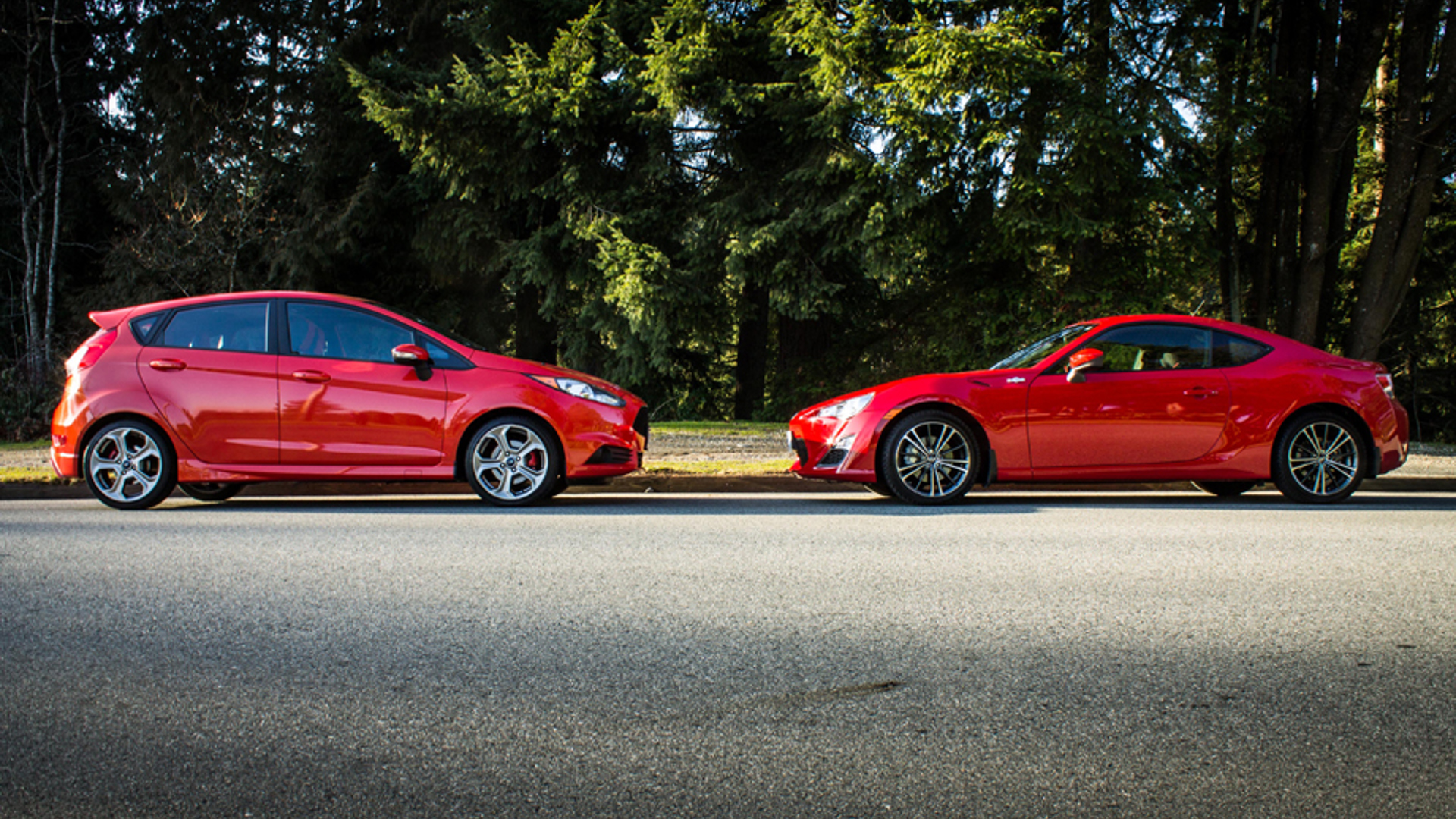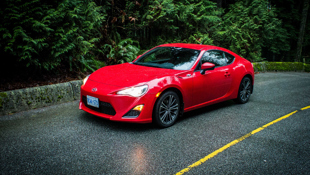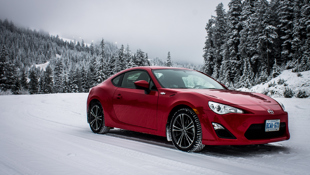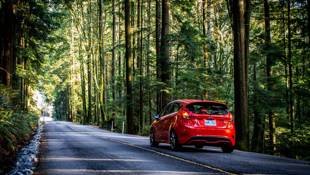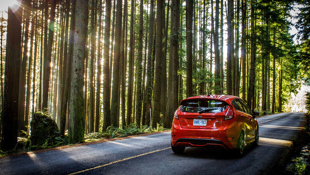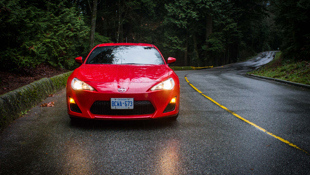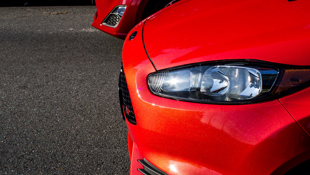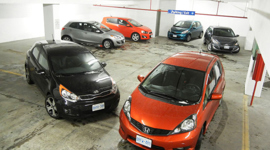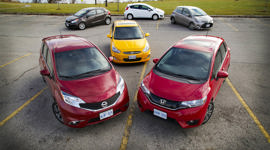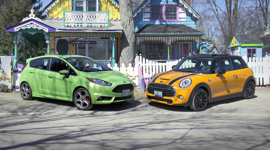Comparison Data
|
Base Price
$26,500
|
$24,999
|
|---|---|
|
A/C Tax
$100
|
$100
|
|
Destination Fee
$1495
|
$1550
|
|
Price as Tested
$28,460
|
$29,749
|
|
Optional Equipment
$365 (Bongiovi Acoustic DPS)
|
$1($400 – Molten Orange tricolour paint; $1200 – power moonroof; $800 – navigation; $700 – premium painted wheels)
|
Some time ago, a study was released showing that North Americans currently had more horsepower on average than at any other time in history. This made me sad.
Have you noticed how all the speed limits across the country have doubled over the years along with the tire-smoking capacity of your average V6 family sedan? No? Well, that's because they haven't. Our cars have gotten faster, quieter, and more capable, but legal restrictions on them are, if anything, more stringent than in the past. By and large, this is fairly sensible, as the pink squishy thing behind the wheel of most cars is, on average, pretty dang fallible. Exhibit A: your ham-fisted humble author.
However, we live in a golden age of motoring, and it ain't about 500+ hp twin-turbo German autobahn annihilators or supercharged muscle cars capable of beating up dedicated track-day cars. I'm not saying these cars are boring, it's just that the boys in red serge and silly hats take rather a dim view of exercising them to anything near their potential.
No, there is another category of automobile that gets the pulse racing, and it's better than ever. It's a class of cars that are forced into modest power by economic restrictions, and end up being better than the heavy hitters because of it. Call them the cheap and cheerful crowd, but don't call it "driving a slow car fast."
Here are two best-of-breed examples: the Ford Fiesta ST and the Scion FR-S. On the face of it, these two have nothing in common. One's a front-driver, the other spins the rear wheels. One's a four-door econobox, the other's a dedicated 2+2 sportster. One has a snootful of turbo power, the other relies on a revvy flat-four.
Really, I'd rather drive either one of these things than a leather-lined ICBM of the type put out by BMW, Audi and Mercedes-Benz. However, I'd also happily pick one of them over the other.
Styling and Practicality
Style: just who are we kidding here? Scion's FR-S looks like an Dragonball-Z reimagining of the Datsun 240SX and the Fiesta ST looks like a microscopic photograph of a dust mite. Neither car is pretty – not exactly.
However, both ride on similar-size 17-inch alloys that won't break the bank when you burn through the first set of tires, and both provide a modicum of practicality. The FR-S is more a 2+2 than a true four-seater, but it is possible to cram a rear-facing child seat in the back, assuming your front-seat passenger is either very short or a masochist.
It's got a semi-useable trunk too, and both rear seats fold properly flat. In comparison to other “proper” sports cars, the FR-S works as a practical proposition.
However, when put up against the Fiesta ST, the competition gets a bit tougher. Unlike the Scion, cramming a child seat out back doesn't require pureeing your front seat passenger in order to make them fit. What's more, actually getting the kid in and out of the car won't cause semi-weekly trips to the chiropractor. Wrangling a toddler into a rear-facing child-seat in the FR-S is a feat best left to members of Cirque du Soleil.
Cargo volume is much better in the ST as well, more than double that of the Scion. As a proper hatchback, it'll easily swallow the new flat-screen TV you can afford if you buy the Ford, which brings us to our next category.
Affordability/Value
Every couple of months, a new column comes out claiming that so-called 'millennials' aren't interested in cars. Horsefeathers and poppy-cock. It's not that they don't want to drive, it's that the job market is tough and the cost of living is high. How shall I explain this in terms that digital natives will understand? Such expenses. Much insurance. So underpaid. Wow.
It's never been tougher scrape together the cash to buy a car, but it's never been a better time to buy one. The FR-S and the Fiesta ST both sticker well under $30K, and are within reach as you finally get those student loans under control.
The base cars are a not-inconsiderable $1,500 apart, with the FR-S at $26,450 and the Fiesta ST at $24,999. If you're completing some level of post-secondary education, Scion will close that gap with a $1000 rebate, and a 0.2 percent reduction in the financing charges.
In both cases, that's a lot of bang for your buck. However, the Ford currently has a bit of an ace up its sleeve. Finance rates are almost never mentioned in comparison testing because they're different every single month, with new incentive programs based on volume and how the manufacturer wants their portfolio balanced between leasing and financing.
Thing is, hardly anybody has 30 grand after taxes stuffed under their mattress these days, so most people choose to use manufacturer financing. The way things stand right now, the Scion is reasonably attractive, with rates of 3.99% up to six years. That plus your beat-up commuter trade-in gives you a financing payment under $450/month – not bad.
Ford, on the other hand, appears to treat their Fiesta ST like any other Fiesta. That means you'll pay nothing in interest for up to six years. Nada. Even if you only have the most minimal of down payments, that nets you a monthly payment with a three on the front of it, assuming you avoid some of the sillier Ford additional options ($400 for paint? Pass). Granted, I can't guarantee this rate disparity will always be the case, but there you have it.
Insurance too, will be wildly variable depending on who you shop with, but as far as most adjusters are concerned, one car is a rear-wheel-drive terror, and the other is a four-door front-wheel-drive hatchback. I won't tell them it comes in “Molten Orange” if you won't.
Fuel bills won't kill you for either vehicle. The flat-four in the FR-S drinks premium brew only, but it's still beer-budget stuff, with the conversion from US EPA rates at 10.7 L/100 km city and 7.8 L/100 km on the highway (this for the six-speed manual).
The Ford is even cheaper to run – it'll take regular gasoline and consume it at 9.0 L/100 km in the city and 6.7 L/100 km on the highway. As it's turbocharged, expect that the Ford might do a little worse than the FR-S in achieving projected numbers when you get on the loud pedal.
Technology
For your basic FR-S, both audio and navigation are extra. Is either worth paying for? Not especially. The interior of pretty much every Scion is built to a cost, and their cluttered touchscreens are a bit dated. You'll pay $1,025 for the premium display with navigation, and $365 for the Bongiovi acoustics upgrade. This last gives value a bad name.
For the Fiesta, you can squander $1,200 on a sunroof if you'd like, but as the extreme curve of the roof puts this so far back it'll only shed the rays on your headrest, why bother? Navigation is an $800 option, but all cars with come with Ford's Sync system for connectivity. It's slicker-looking than the Scion's setup, if not completely free of frustrations.
Driving 1 – Commuting
Before we jump right into the tire-spinning stuff, a pair of commutes. Both these cars are likely to pull double duty: you might be able to tuck a track-only, heavily modified FR-S in your garage if you've got a winter beater, but odds are, this is the daily driver.
As such, it'll have to get you back and forth to work so you can actually earn enough to pay for the damn thing. Early Sunday morning hijinks are all well and good, but if it's a bed of nails the rest of the week, some of that charm might be lost.
Surprisingly, it's the FR-S that's the more comfy of the pair. While the Scion is noisier, rougher-riding, and equipped with an interior that is not only inexpensive, but just plain cheap, it does have the better seats.
The seats in the Fiesta ST, on the other hand, pinch butt like Silvio Berlusconi. Good grief – even if you're a beanpole, these Recaros are just like those in the Focus ST. They don't coddle, they clench.
It's just not comfortable. Leaving that aside, it's certainly a quieter car than the FR-S, and while both cars have darty steering, the driving position is a tad more relaxed in the Fiesta.
A bigger difference is in the way each vehicle delivers power under light throttle. Not since the Mazda RX-8 has a vehicle had a feebler torque delivery than the 2.0L pancake-four in the FR-S: flog it like a rented burro and it comes alive; roll into the throttle on an uphill section and you might as well be behind the wheel of a mid-90s Civic DX.
The Fiesta ST might be just a cheap compact car with a mid-size sedan's motor, but what an engine it is. The 1.6L turbo has endless, effortless low-end power, and while it does its best under revs, it's also a no-downshift proposition when motoring up hills if you've got the cruise control on. It's easy to drive, but jeez, those seats.
Driving 2 – Performance
And now, practically the only thing that really matters: just how good are these things to drive?
There's just all kinds of good news here. First, because my FR-S tester is running on proper dedicated winter tires, the silly low-traction Prius set that comes as standard doesn't hamper the car. Just like many other performance cars in the past (Potenza RE92s on the 1st gen WRX?) the factory tires are one of the first things any owner will chuck.
With a little extra grip despite the poor weather, the FR-S simply shines. Its twin, the BRZ, might have better resale value down the line, but the Scion's more neutrally tuned suspension is better. The FR-S sits low, corners flat, and positively begs to be driven hard. I'd still maintain that its four-cylinder could be a tad more tuneful, but it's a great drive.
Lift throttle mid-corner and the tail will come around just slightly – back on the power and the FR-S gives just the slightest slither. It's not just a hoot, it's plenty quick if you exploit the revs to extract every one of those 200 horses. What's more, the gradual power delivery, balanced chassis, and proper winter footwear disposes of any argument that you really need an all-wheel-drive or front-wheel-drive car as a year-rounder.
However.
Paper-racers will take one look at the front-wheel-drive layout of the Fiesta ST and scoff. Their loss.
This isn't a car, it's a puppy. Pull the same lift-throttle trick as with the FR-S, and the ST wriggles its little tail – stomp the throttle and the diminutive four-pot turbo spools right up and blasts out of the corner with even more verve than the FR-S.
If our yardstick is on-track performance, the Fiesta's brake-based electronic differential might rule the roost in an autocross session, but also might overheat on a prolonged lapping session. If we're just talking about fun, this scrappy little hatch hands the former bang-for-buck champion its tail. The Fiesta ST isn't just more fun than the rear-driver, it's more fun than cars costing thrice as much.
Yes, there's a little torque steer, and yes, lighting up the front tires ain't as cool as smoking the rears in a long smoky slide, but it's hard to care. The ST is a cross-town rocket, a backroads hooligan, and perfectly capable of crossing distance at speed. You can't help but love it.
Wife Will Kill You Modifier
“Sweetheart? If I just showed up unannounced having bought one of these cars, which one would you be less mad about?”
“I don't really care about them enough. I'd probably kill you either way.”
Well. That's not as helpful as I thought it would be. Call it a draw.
Conclusion
Who's the winner? We all are! Seriously, how great is it to have two world-class machines like this priced not much more than your average compact car?
But as far as the winner of David vs. David, it's the Fiesta ST that's the favourite. It's cheaper to buy, cheaper to own, more liveable, and just as much fun to drive as the FR-S, if not more. It wags its tail so enthusiastically you can't help but want to take it home – please Ma, can I keep it?
